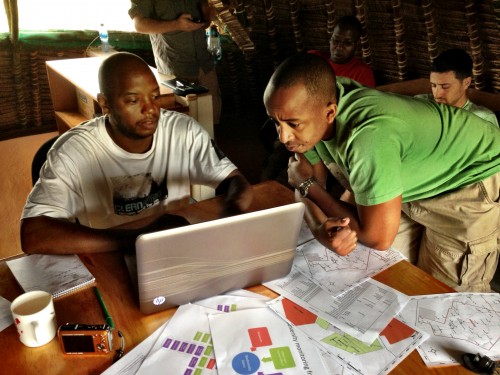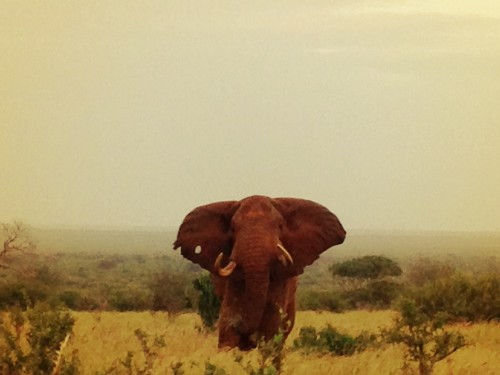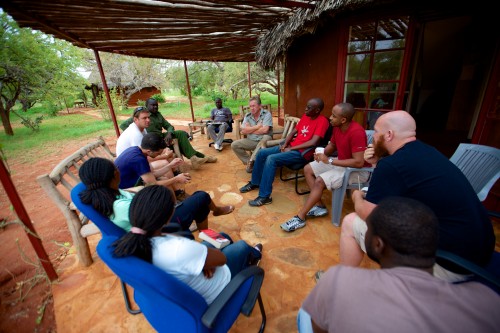I’m disconnected. Off-grid in the usually dusty and dry (though green currently) Tsavo region of Kenya with seven others from the Ushahidi team as we look into whether or not technology can be useful on the Rukinga Sanctuary.
We’re here to see if our technology, or the knowledge of what can be done with tech, is useful in carbon monitoring of deforestation, security operations with rangers and/or better engaging with the surrounding community?
The Wildlife Works team has an extensive for-profit program around carbon credits, carbon offsets, and small factories in an EPZ where brands like Puma get their “made in Kenya” stamp. It’s maybe the most impressive example of what could be termed a “social enterprise” that I’ve ever seen. Over 300 people have jobs due to their presence, and all in the community monetarily benefit from their activities.
The 75,000 acre sanctuary sits just south of Voi, off the Mombasa road. Rukinga was the first place in the world to be VCS (verified carbon standard) verified and REDD (Reduced Emissions from Deforestation and Degradation) certified by the UN, and has since grown to encompass the 13 other ranches and 1/2 million acres surrounding them. 60,000 people in the communities surrounding them are financial beneficiaries from the project.
Last year they sold sold 1.4 million tons of carbon credits for around $6-8 per ton. The revenue from that is split into three parts; 1/3 goes to the land owner(s), 1/3 goes to the managing company (Wildlife Works) and 1/3 goes to the community. Interestingly, unlike a lot of NGO work, the team doesn’t decide how the community should benefit. The community decides how to spend the money, through their own local committees, and it’s led to a huge amount of school bursaries (2,000 kids now in secondary and tertiary schools), water catchements and other public works.
It’s impressive.
So, what does Wildlife Works really do at Rukinga?
In short, they try to increase the amount of trees, protect the animals, while balancing that with the local community.
This is where the problems arise as there are encroachments for wood by charcoal burners and poachers killing the elephants. Due to the community benefiting from the ranches, there has been a decrease in the amount of charcoal burners and even the local poison-arrow elephant poachers and bushmeat hunters have reduced.
However, there’s a much bigger problem, that of commercial poachers (mostly of Somali descent) who come down from NE Kenya, with sophisticated weapons and who are experienced in tactical movement. They come in teams of 2-10, using their mobile phones for coordination, moving fast and anchoring off the Mombasa Highway. Often they have buried caches of guns and ivory on the ranch, so they don’t even carry those in or out with them, and they can blend in easily.
18 rhinos have been killed since the holidays in Kenya alone, and elephant tusks sell for around $300/kilo, so provides a massive incentive for income for anyone.
“We’ve been working in Kenya for the past 17 years… We lost 10 elephants to ivory poachers in the first 15 years, and 45 in the last 18 months, and this is despite being a relatively well-funded organization with extraordinary relationships with the local community members who benefit from wildlife,†says Wildlife Works founder and CEO Mike Korchinsky.
The rangers have no weapons. They are highly skilled at finding and tracking the poachers, but need the Kenya Wildlife Service (KWS) to come if they’re going to catch someone. KWS is sometimes slow to respond, and they’re not willing to put their life on the line in order to catch or kill the poachers. When a poacher is caught, the laws are not stiff enough to disincentivize others.
The Tech
So, where can tech help? We don’t know yet, is the answer.
To frame the problem of biodiversity protection, if you get to the animal or tree after it’s dead, then it’s too late. What you really want is prevention. If you can’t get prevention, then you need swift and effective response.
Prevention
We’re wondering if there’s a way to get the community interacting through SMS to pass on information about illegal activities. Beyond informants, we’re thinking that there might be a useful way to connect the local community monitors and make reporting on human-wildlife conflicts more efficient.
Response
The teams of 100+ rangers are on foot a lot, carry a GPS and do have some mobile coverage. They create reports when they come in, and their goal is to be light, hardy and fast. All of them already carry cheap Nokia-type phones, so can send SMS and call, and we’re thinking that a very simple text messaging system as a hub might come in handy for coordination and archived messaging for later assessment (and possibly mapping).
Other Ideas
- There is a lack of information on all types of location-based data, especially once you get off the main road. There’s an opportunity to do a community-level mapping exercise, tied to Open Street Map.
- The process for getting GPS-related data from the rangers to HQ and then a map takes a couple weeks. Surely there is a way to make this more efficient.
- Related to the rangers data is that they rarely see the output of the GPS data and forms that they fill out. Could we create a faster way to visualize it, and let them see their work?
- It seems to me that if you were able to gather the phones and SIM cards off caught poachers, then you could start dumping their address books and pattern matching for similarities. We could also see if it is possible to streamline the process for legally getting call log data for those SIM cards from the mobile operators.
The camp we’re staying at is situated has a generator that provides backup power in the evenings for a few hours, where we get our daily recharge-dose for our gadgets. If you stand in just the right place you get one bar of connectivity on your phone and send out text messages.
It’s a shock to our digitally connected system when we find ourselves without a digital tether. It’s also a wonderful reminder of the constraints that real life problems have, where technology helps and/or hinders and why simple solutions tend to be the best.
While we’d love to just shove an Android phone in every rangers pocket, it’s probably not the answer. Instead, as my battery dies, I sit here thinking that we’ll revert to our simplest messaging solution (aka SMS) for any communications tools. It also reminds me that technology is at it’s best when it’s a small component that makes one thing work better, faster or more efficiently. If all we were to do was take one pain point out of the Wildlife Works people’s lives, then that would be enough.
(Sidenote: Limo rubs it in that his Blackberry gets messages and calls, and much to my shame he’s right, it’s better than any of the Android of iPhone devices for connection on the edge of network connectivity. Maybe there is still a place for RIM…)
A huge thanks to Taylor Martyn for coming with us and taking some great pictures (seen here)!


